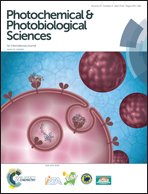Topical formulation containing hesperidin methyl chalcone inhibits skin oxidative stress and inflammation induced by ultraviolet B irradiation
Abstract
Skin exposure to ultraviolet B (UVB) irradiation has increased significantly in recent years due to ozone depletion, and it represents the main cause of many skin diseases. Hesperidin methyl chalcone (HMC) is a compound used to treat vascular diseases that has demonstrated anti-inflammatory activities in pre-clinical studies. Herein, we tested the antioxidant activity of HMC in cell free systems and the in vivo effects of a stable topical formulation containing HMC in a mouse model of skin oxidative stress and inflammation induced by UVB irradiation. HMC presented ferric reducing power, neutralized 2,2′-azino-bis (3-ethylbenzothiazoline-6-sulfonic acid) (ABTS) and hydroxyl free radicals, and inhibited lipid peroxidation. In hairless mice, a topical formulation containing HMC inhibited UVB irradiation-induced skin edema, depletion of antioxidant capacity (ferric and ABTS reducing abilities and catalase activity), lipid peroxidation, superoxide anion production and mRNA expression of gp91phox (nicotinamide adenine dinucleotide phosphate [NADPH] oxidase 2 sub-unity). In addition, HMC inhibited UVB irradiation-induced depletion of reduced glutathione levels by maintaining glutathione peroxidase-1 and glutathione reductase mRNA expression, prevented down-regulation of nuclear factor erythroid 2-related factor 2 (Nrf2) mRNA expression and increased heme oxygenase-1 mRNA expression. Finally, we demonstrated that topical application of the formulation containing HMC inhibited cytokine (TNF-α, IL-1β, IL-6, and IL-10) production induced by UVB irradiation. Therefore, this topical formulation containing HMC is a promising new therapeutic approach to protecting the skin from the deleterious effects of UVB irradiation.



 Please wait while we load your content...
Please wait while we load your content...